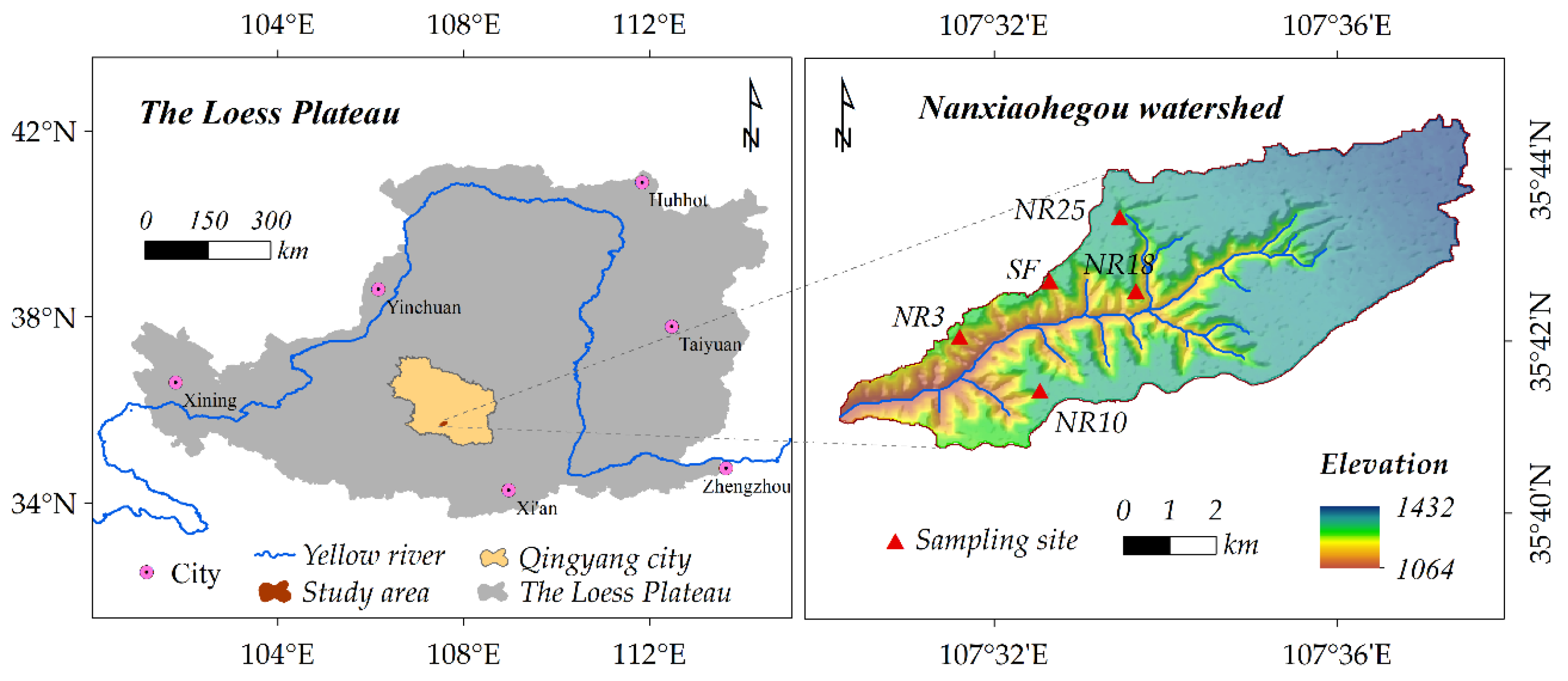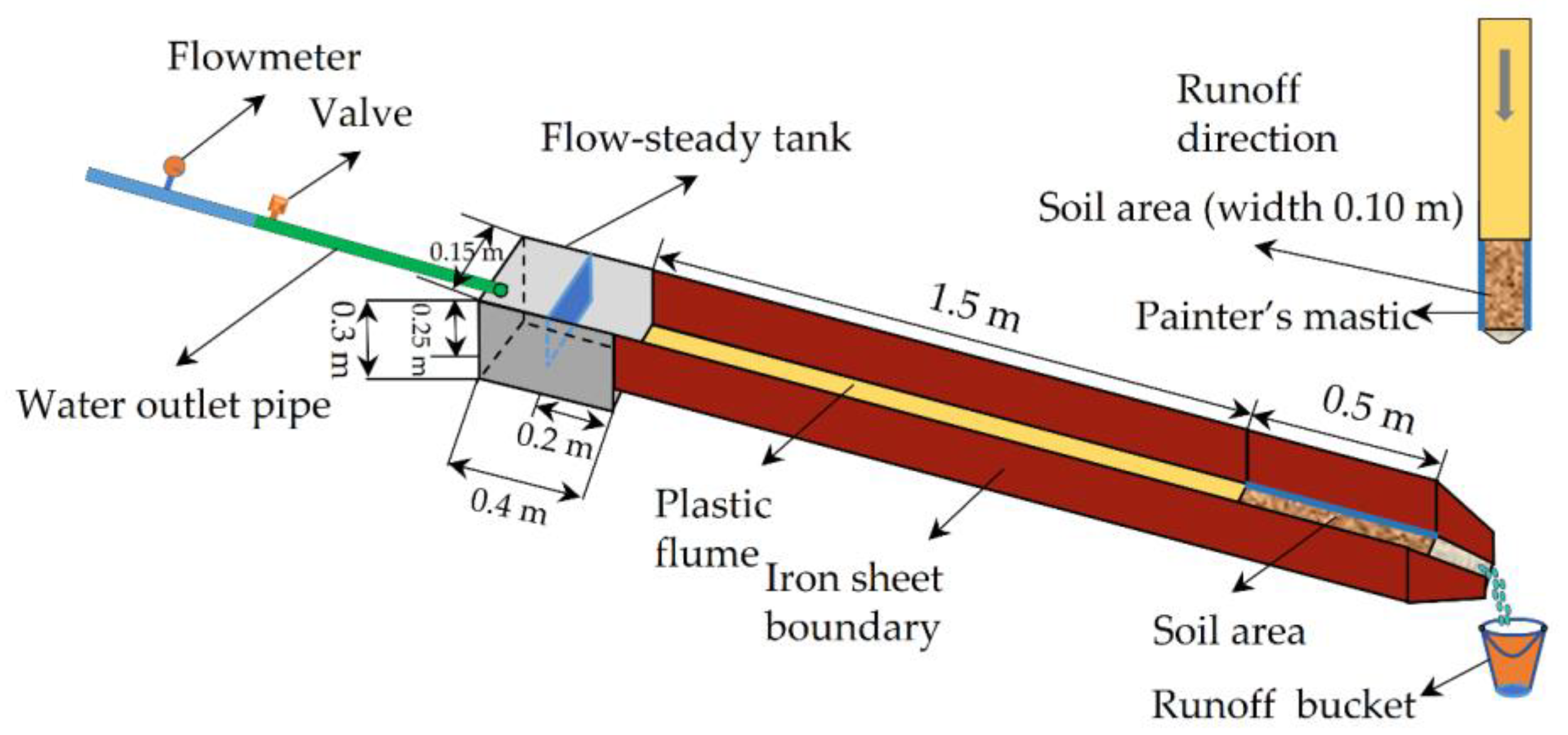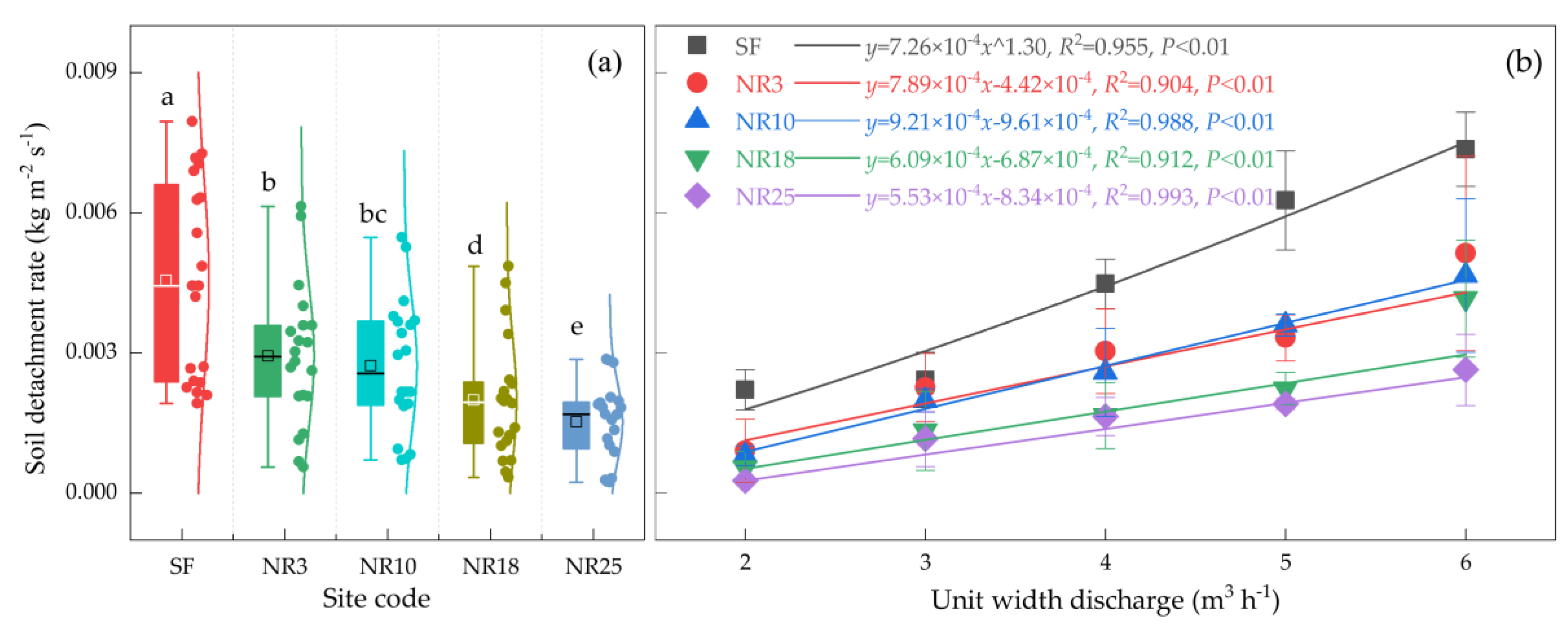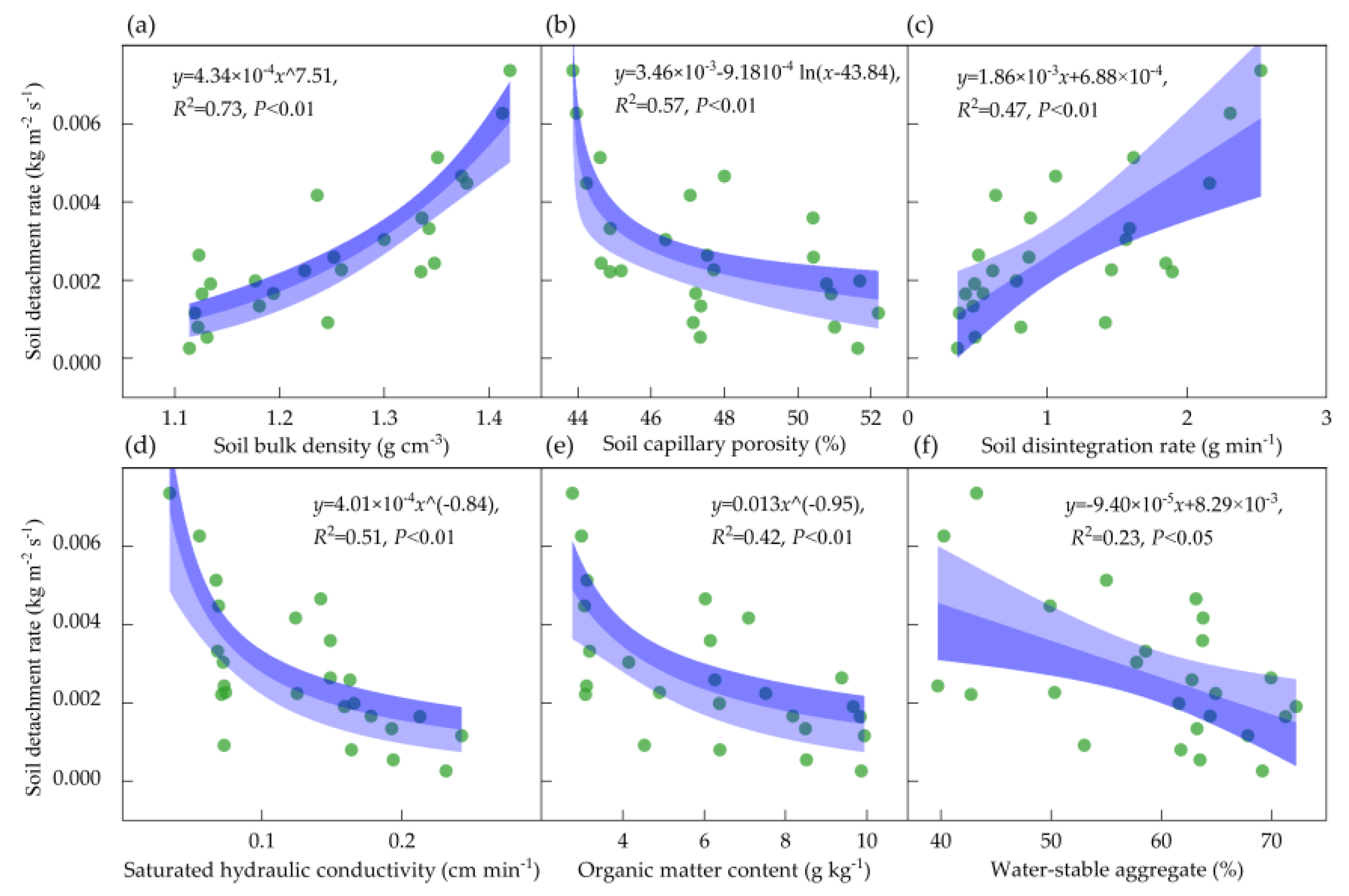Variations in Soil Erosion Resistance of Gully Head Along a 25-Year Revegetation Age on the Loess Plateau
Abstract
1. Introduction
2. Material and Method
2.1. Study Area
2.2. Sampling Sites Selection
2.3. Sampling and Measurement of Soil and Root
2.4. Hydraulic Flume Experiments
2.5. Parameter Calculation after the Experiments
2.6. Statistical Analysis and Plotting
3. Results and Discussion
3.1. Effect of Revegetation on Soil and Root Properties of Gully Heads
3.2. Effect of Revegetation Age on Soil Detachment of Gully Heads
3.3. Response of Soil Detachment to Soil Properties
3.4. Response of Soil Loss of Gully-Head to Root Traits
3.5. Effect of Revegetation Age on Soil Erosion Resistance of Gully Head
4. Conclusions
Author Contributions
Funding
Acknowledgments
Conflicts of Interest
References
- Mohammed, S.; Al-Ebraheem, A.; Holb, I.J.; Alsafadi, K.; Dikkeh, M.; Pham, Q.B.; Linh, N.T.T.; Szabo, S. Soil management effects on soil water erosion and runoff in central Syria—A comparative evaluation of general linear model and random forest regression. Water 2020, 12, 2529. [Google Scholar] [CrossRef]
- Hao, H.X.; Cheng, L.; Guo, Z.L.; Wang, L.; Shi, Z.H. Plant community characteristics and functional traits as drivers of soil erodibility mitigation along a land degradation gradient. Land Degrad. Dev. 2020, 31, 1851–1863. [Google Scholar] [CrossRef]
- Zarris, D.; Lykoudi, E.; Panagoulia, D. Assessing the impacts of sediment yield on the sustainability of major hydraulic systems. In Proceedings of the International Conference “Protection and Restoration of the Environment VIII”, Chania, Greece, 3–7 July 2006. [Google Scholar]
- Brazier, R.E.; Beven, K.J.; Freer, J.; Rowan, J.S. Equifinality and uncertainty in physically based soil erosion models: Application of the GLUE methodology to WEPP–the water erosion prediction project–for sites in the UK and USA. Earth Surf. Process. Landf. 2000, 25, 825–845. [Google Scholar] [CrossRef]
- Kinnell, P.; Risse, L.M. USLE-M: Empirical modeling rainfall erosion through runoff and sediment concentration. Soil Sci. Soc. Am. J. 1998, 62, 1667–1672. [Google Scholar] [CrossRef]
- Nearing, M.A.; Foster, G.R.; Lane, L.J.; Finkner, S.C. A process-based soil erosion model for USDA-water erosion prediction project technology. Trans. ASAE 1989, 32, 1587–1593. [Google Scholar] [CrossRef]
- Efthimiou, N.; Lykoudi, E.; Panagoulia, D.; Karavitis, C. Assessment of soil susceptibility to erosion using the EPM and RUSLE models: The case of Venetikos river catchment. Glob. Nest. J. 2016, 18, 164–179. [Google Scholar]
- Guo, W.Z.; Kang, H.L.; Wang, W.L.; Guo, M.M.; Chen, Z.X. Erosion-reducing effects of revegetation and fish-scale pits on steep spoil heaps under concentrated runoff on the Chinese Loess Plateau. Land Degrad. Dev. 2020. [Google Scholar] [CrossRef]
- Gramlich, A.; Stoll, S.; Stamm, C.; Walter, T.; Prasuhn, V. Effects of artificial land drainage on hydrology, nutrient and pesticide fluxes from agricultural fields—A review. Agric. Ecosyst. Environ. 2018, 266, 84–99. [Google Scholar] [CrossRef]
- Kervroëdan, L.; Armand, R.; Saunier, M.; Ouvry, J.; Faucon, M. Plant functional trait effects on runoff to design herbaceous hedges for soil erosion control. Ecol. Eng. 2018, 118, 143–151. [Google Scholar] [CrossRef]
- Sun, L.; Zhang, G.H.; Luan, L.L.; Liu, F. Temporal variation in soil resistance to flowing water erosion for soil incorporated with plant litters in the Loess Plateau of China. Catena 2016, 145, 239–245. [Google Scholar] [CrossRef]
- Chang, E.; Li, P.; Li, Z.; Su, Y.; Zhang, Y.; Zhang, J.; Liu, Z.; Li, Z. The impact of vegetation successional status on slope runoff erosion in the Loess Plateau of China. Water 2019, 11, 2614. [Google Scholar] [CrossRef]
- Wang, B.; Zhang, G.H.; Shi, Y.Y.; Zhang, X.C. Soil detachment by overland flow under different vegetation restoration models in the Loess Plateau of China. Catena 2014, 116, 51–59. [Google Scholar] [CrossRef]
- Li, Z.W.; Zhang, G.H.; Geng, R.; Wang, H.; Zhang, X.C. Land use impacts on soil detachment capacity by overland flow in the Loess Plateau, China. Catena 2015, 124, 9–17. [Google Scholar] [CrossRef]
- Yu, Y.C.; Zhang, G.H.; Geng, R.; Sun, L. Temporal variation in soil detachment capacity by overland flow under four typical crops in the Loess Plateau of China. Biosyst. Eng. 2014, 122, 139–148. [Google Scholar] [CrossRef]
- Wang, B.; Zhang, G.H.; Shi, Y.Y.; Zhang, X.C.; Ren, Z.P.; Zhu, L.J. Effect of natural restoration time of abandoned farmland on soil detachment by overland flow in the Loess Plateau of China. Earth Surf. Process. Landf. 2013, 38, 1725–1734. [Google Scholar] [CrossRef]
- Scherer, U.; Zehe, E.; Tr Bing, K.; Kai, G. Prediction of soil detachment in agricultural loess catchments: Model development and parameterisation. Catena 2012, 90, 63–75. [Google Scholar] [CrossRef]
- Zhang, G.H.; Tang, M.K.; Zhang, X.C. Temporal variation in soil detachment under different land uses in the Loess Plateau of China. Earth Surf. Process. Landf. 2010, 34, 1302–1309. [Google Scholar] [CrossRef]
- Bernard, B.; Roose, E. Aggregate stability as an indicator of soil susceptibility to runoff and erosion; validation at several levels. Catena 2002, 47, 133–149. [Google Scholar]
- Knapen, A.; Poesen, J.; Govers, G.; Baets, S.D. The effect of conservation tillage on runoff erosivity and soil erodibility during concentrated flow. Hydrol. Process. 2008, 22, 1497–1508. [Google Scholar] [CrossRef]
- Guo, M.M.; Wang, W.L.; Wang, T.C.; Wang, W.X.; Kang, H.L. Impacts of different vegetation restoration options on gully head soil resistance and soil erosion in loess tablelands. Earth Surf. Process. Landf. 2020, 45, 1038–1050. [Google Scholar] [CrossRef]
- Lazarovitch, N.; Vanderborght, J.; Jin, Y.; van Genuchten, M.T. The root zone: Soil physics and beyond. Vadose Zone J. 2018, 17, 1–6. [Google Scholar] [CrossRef]
- Panagoulia, D. Hydrological modelling of a medium-size mountainous catchment from incomplete meteorological data. J. Hydrol. 1992, 137, 279–310. [Google Scholar] [CrossRef]
- Falkenmark, M. Land and water integration and river basin management. FAO Land Water Bull. 1995, 1, 15–16. [Google Scholar]
- Baets, S.D.; Poesen, J. Empirical models for predicting the erosion-reducing effects of plant roots during concentrated flow erosion. Geomorphology 2010, 118, 425–432. [Google Scholar] [CrossRef]
- Guo, M.M.; Wang, W.L.; Shi, Q.H.; Chen, T.D.; Kang, H.L.; Li, J.M. An experimental study on the effects of grass root density on gully headcut erosion in the gully region of China’s Loess Plateau. Land Degrad. Dev. 2019, 30, 2107–2125. [Google Scholar] [CrossRef]
- Khanal, A.; Fox, G.A. Detachment characteristics of root-permeated soils from laboratory jet erosion tests. Ecol. Eng. 2017, 100, 335–343. [Google Scholar] [CrossRef]
- De Baets, S.; Poesen, J.; Gyssels, G.; Knapen, A.; Adili, A.A. Effects of grass roots on the erodibility of topsoils during concentrated flow. Geomorphology 2006, 76, 54–67. [Google Scholar] [CrossRef]
- Mamo, M.; Bubenzer, G.D. Detachment rate, soil erodibility, and soil strength as influenced by living plant roots part II: Field study. Trans. ASAE 2001, 5, 1175–1181. [Google Scholar] [CrossRef]
- Mamo, M.; Bubenzer, G.D. Detachment rate, soil erodibility, and soil strength as influenced by living plant roots part I: Laboratory study. Trans. ASAE 2001, 5, 1167–1174. [Google Scholar] [CrossRef]
- Baets, S.D.; Poesen, J.; Knapen, A.; Galindo, P. Impact of root architecture on the erosion-reducing potential of roots during concentrated flow. Earth Surf. Process. Landf. 2007, 32, 1323–1345. [Google Scholar] [CrossRef]
- Shi, Q.; Wang, W.; Guo, M.; Chen, Z.; Feng, L.; Zhao, M.; Xiao, H. The impact of flow discharge on the hydraulic characteristics of headcut erosion processes in the gully region of the Loess Plateau. Hydrol. Process. 2019, 34, 718–729. [Google Scholar] [CrossRef]
- Guo, M.M.; Wang, W.L.; Kang, H.L.; Yang, B. Changes in soil properties and erodibility of gully heads induced by vegetation restoration on the Loess Plateau, China. J. Arid Land 2018, 10, 712–725. [Google Scholar] [CrossRef]
- Fu, B.; Chen, L.; Ma, K.; Zhou, H.; Wang, J. The relationships between land use and soil conditions in the hilly area of the loess plateau in northern Shaanxi, China. Catena 2000, 39, 69–78. [Google Scholar] [CrossRef]
- Xiong, Y.; Zhou, J.Z.; Chen, L.; Jia, B.J.; Sun, N.; Tian, M.Q.; Hu, G.H. Land use pattern and vegetation cover dynamics in the three Gorges Reservoir (TGR) intervening Basin. Water 2020, 12, 2036. [Google Scholar] [CrossRef]
- Jiao, J.Y.; Tzanopoulos, J.; Xofis, P.; Bai, W.J.; Ma, X.H.; Mitchley, J. Can the study of natural vegetation succession assist in the control of soil erosion on abandoned croplands on the Loess Plateau, China? Restor. Ecol. 2007, 15, 391–399. [Google Scholar] [CrossRef]
- Wang, B.; Liu, G.B.; Xue, S.; Zhu, B.B. Changes in soil physico-chemical and microbiological properties during natural succession on abandoned farmland in the Loess Plateau. Environ. Earth Sci. 2011, 62, 915–925. [Google Scholar] [CrossRef]
- Chen, Y.P.; Wang, K.B.; Lin, Y.S.; Shi, W.Y.; Song, Y.; He, X.H. Balancing green and grain trade. Nat. Geosci. 2015, 8, 739–741. [Google Scholar] [CrossRef]
- Kompani-Zare, M.; Soufi, M.; Hamzehzarghani, H.; Dehghani, M. The effect of some watershed, soil characteristics and morphometric factors on the relationship between the gully volume and length in Fars Province, Iran. Catena 2011, 86, 150–159. [Google Scholar] [CrossRef]
- Guo, M.M.; Wang, W.L.; Kang, H.L.; Yang, B.; Li, J.M. Changes in soil properties and resistance to concentrated flow across a 25-year passive restoration chronosequence of grasslands on the Chinese Loess Plateau. Restor. Ecol. 2020, 28, 104–114. [Google Scholar] [CrossRef]
- Luk, S.H.; Merz, W. Use of the salt tracing technique to determine the velocity of overland flow. Sci. Total Environ. 1992, 5, 289–301. [Google Scholar]
- Li, Y.; Xu, X.Q.; Zhu, X.M.; Tian, J.Y. Effectiveness of plant roots on increasing the soil permeability on the Loess Plateau. Chin. Sci. Bull. 1992, 37, 1735–1738. [Google Scholar]
- Hill, A.V. The possible effects of the aggregation of the molecules of haemoglobin on its dissociation curves. J. Physiol. 1910, 40, 4–7. [Google Scholar]
- Li, Y.; Zhu, X.M.; Tian, J.Y.; Al-Ebraheem, A. Effectiveness of plant roots to increase the anti-scouribility of soil on the Loess Plateau. Chin. Sci. Bull. 1991, 36, 2077–2082. [Google Scholar]
- Gros, R.; Jocteur Monrozier, L.; Bartoli, F.; Chotte, J.L.; Faivre, P. Relationships between soil physico-chemical properties and microbial activity along a restoration chronosequence of alpine grasslands following ski run construction. Appl. Soil Ecol. 2004, 27, 7–22. [Google Scholar] [CrossRef]
- Li, Y.Y.; Shao, M.A. Change of soil physical properties under long-term natural vegetation restoration in the Loess Plateau of China. J. Arid. Environ. 2006, 64, 77–96. [Google Scholar] [CrossRef]
- Jiao, F.; Wen, Z.M.; An, S.S. Changes in soil properties across a chronosequence of vegetation restoration on the Loess Plateau of China. Catena 2011, 86, 110–116. [Google Scholar] [CrossRef]
- Zhao, Y.G.; Wu, P.T.; Zhao, S.W.; Feng, H. Variation of soil infiltrability across a 79-year chronosequence of naturally restored grassland on the Loess Plateau, China. J. Hydrol. 2013, 504, 94–103. [Google Scholar] [CrossRef]
- Six, J.; Elliott, E.T. Aggregation and soil organic matter accumulation in cultivated and native grassland soils. Soil Sci. Soc. Am. J. 1998, 62, 1367–1377. [Google Scholar] [CrossRef]
- Six, J.; Bossuyt, H.; Degryze, S.; Denef, K. A history of research on the link between (micro)aggregates, soil biota, and soil organic matter dynamics. Soil Tillage Res. 2004, 79, 7–31. [Google Scholar] [CrossRef]
- Six, J.; Paustian, K.; Elliott, E.T.; Combrink, C. Soil structure and organic matter I. distribution of aggregate-size classes and aggregate-associated carbon. Soil Sci. Soc. Am. J. 2000, 64, 681–689. [Google Scholar] [CrossRef]
- Kong, A.Y.Y.; Six, J.; Bryant, D.C.; Denison, R.F.; Kessel, C.V. The relationship between carbon input, aggregation, and soil organic carbon stabilization in sustainable cropping systems. Soil Sci. Soc. Am. J. 2005, 69. [Google Scholar] [CrossRef]
- Shangguan, Z.P.; Zheng, C.Z. Soil anti-scouribility enhanced by plant roots. J. Integr. Plant Biol. 2005, 47, 676–682. [Google Scholar]
- Adili, A.A.; Azzam, R.; GiovanniSpagnoli, S.J. Strength of soil reinforced with fiber materials (Papyrus). Soil Mech. Found. Eng. 2012, 48, 241–247. [Google Scholar] [CrossRef]
- Neves, C.S.V.J.; Feller, C.; Guimarães, M.F.; Medina, C.C.; Tavares Filho, J.; Fortier, M. Soil bulk density and porosity of homogeneous morphological units identified by the cropping profile method in clayey oxisols in Brazil. Soil Tillage Res. 2003, 71, 109–119. [Google Scholar] [CrossRef]
- Zhang, B.J.; Zhang, G.H.; Yang, H.Y.; Wang, H. Soil resistance to flowing water erosion of seven typical plant communities on steep gully slopes on the Loess Plateau of China. Catena 2019, 173, 375–383. [Google Scholar] [CrossRef]
- Fattet, M.; Fu, Y.; Ghestem, M.; Ma, W.; Foulonneau, M.; Nespoulous, J.; Le Bissonnais, Y.; Stokes, A. Effects of vegetation type on soil resistance to erosion: Relationship between aggregate stability and shear strength. Catena 2011, 87, 60–69. [Google Scholar] [CrossRef]
- Podwojewski, P.; Orange, D.; Jouquet, P.; Valentin, C.; Nguyen, V.T.; Janeau, J.L.; Tran, D.T. Land-use impacts on surface runoff and soil detachment within agricultural sloping lands in Northern Vietnam. Catena 2008, 74, 109–118. [Google Scholar] [CrossRef]
- Gyssels, G.; Poesen, J. The importance of plant root characteristics in controlling concentrated flow erosion rates. Earth Surf. Process. Landf. 2003, 28, 371–384. [Google Scholar] [CrossRef]
- Amézketa, E. Soil aggregate stability: A review. J. Integr. Plant Biol. 1999, 14, 83–151. [Google Scholar] [CrossRef]
- Gyssels, G.; Poesen, J.; Bochet, E.; Li, Y. Impact of plant roots on the resistance of soils to erosion by water: A review. Prog. Phys. Geogr. 2005, 29, 189–217. [Google Scholar] [CrossRef]










| Site Code | Restoration Age (yr) | Slope (°) | Coverage (%) | Altitude (m) | Dominant Communities | Main Companion Species |
|---|---|---|---|---|---|---|
| SF | 0 | 2.4 | — | 1420 | Zea mays | Setaria viridis |
| NR3 | 3 | 2.9 | 72.3 | 1405 | Artemisia capillaris | Artemisia sacrorum |
| NR10 | 10 | 2.4 | 80.8 | 1401 | Artemisia sacrorum | Artemisia capillaris |
| NR18 | 18 | 3.2 | 93.4 | 1390 | Artemisia sacrorum | Artemisia capillaris |
| NR25 | 25 | 3.1 | 91.2 | 1380 | Bothriochloa ischaemum | Artemisia sacrorum + Lespedeza daurica |
| Source | SS | Df | MS | F | p-Value |
|---|---|---|---|---|---|
| Revegetation age | 1.08 × 10−4 | 4 | 2.69 × 10−5 | 151.44 | <0.001 |
| Unit width discharge | 1.75 × 10−4 | 4 | 4.38 × 10−5 | 246.48 | <0.001 |
| Revegetation age × Unit width discharge | 2.29 × 10−5 | 16 | 1.43 × 10−6 | 8.07 | <0.001 |
| Error | 1.33 × 10−5 | 75 | 1.78 × 10−7 | ||
| Total | 0.0011 | 100 |
Publisher’s Note: MDPI stays neutral with regard to jurisdictional claims in published maps and institutional affiliations. |
© 2020 by the authors. Licensee MDPI, Basel, Switzerland. This article is an open access article distributed under the terms and conditions of the Creative Commons Attribution (CC BY) license (http://creativecommons.org/licenses/by/4.0/).
Share and Cite
Chen, Z.; Guo, M.; Wang, W. Variations in Soil Erosion Resistance of Gully Head Along a 25-Year Revegetation Age on the Loess Plateau. Water 2020, 12, 3301. https://doi.org/10.3390/w12123301
Chen Z, Guo M, Wang W. Variations in Soil Erosion Resistance of Gully Head Along a 25-Year Revegetation Age on the Loess Plateau. Water. 2020; 12(12):3301. https://doi.org/10.3390/w12123301
Chicago/Turabian StyleChen, Zhuoxin, Mingming Guo, and Wenlong Wang. 2020. "Variations in Soil Erosion Resistance of Gully Head Along a 25-Year Revegetation Age on the Loess Plateau" Water 12, no. 12: 3301. https://doi.org/10.3390/w12123301
APA StyleChen, Z., Guo, M., & Wang, W. (2020). Variations in Soil Erosion Resistance of Gully Head Along a 25-Year Revegetation Age on the Loess Plateau. Water, 12(12), 3301. https://doi.org/10.3390/w12123301






